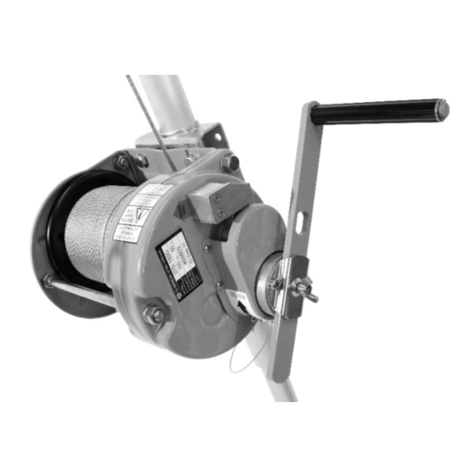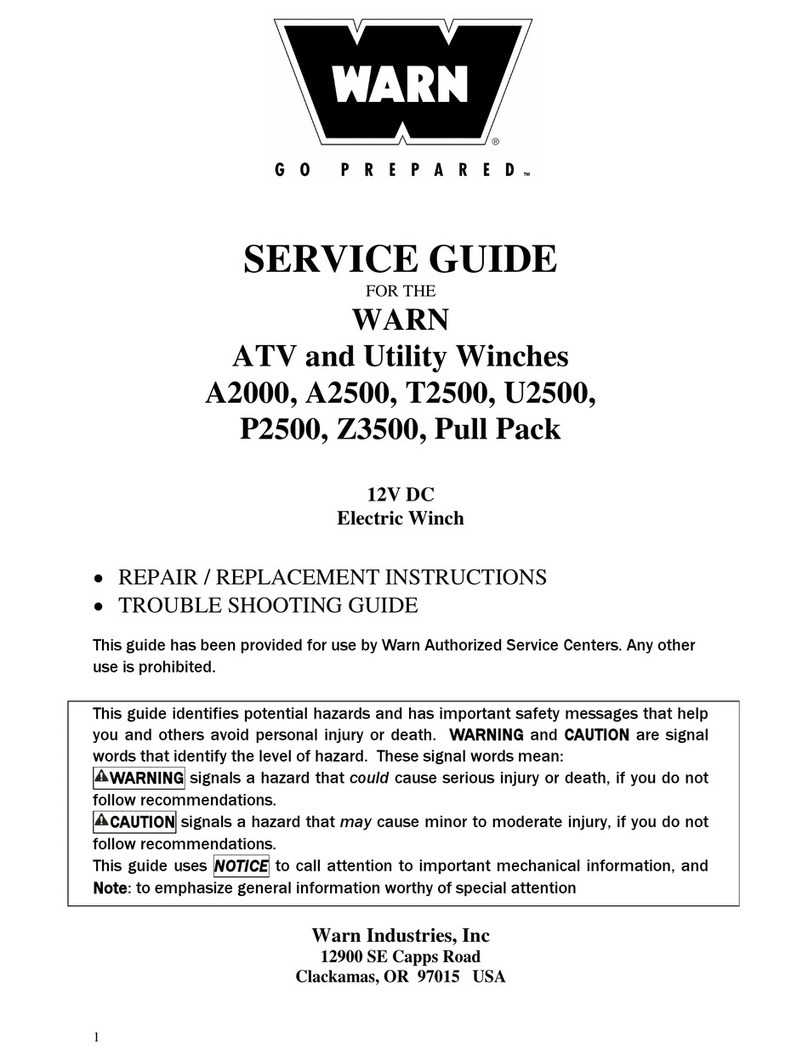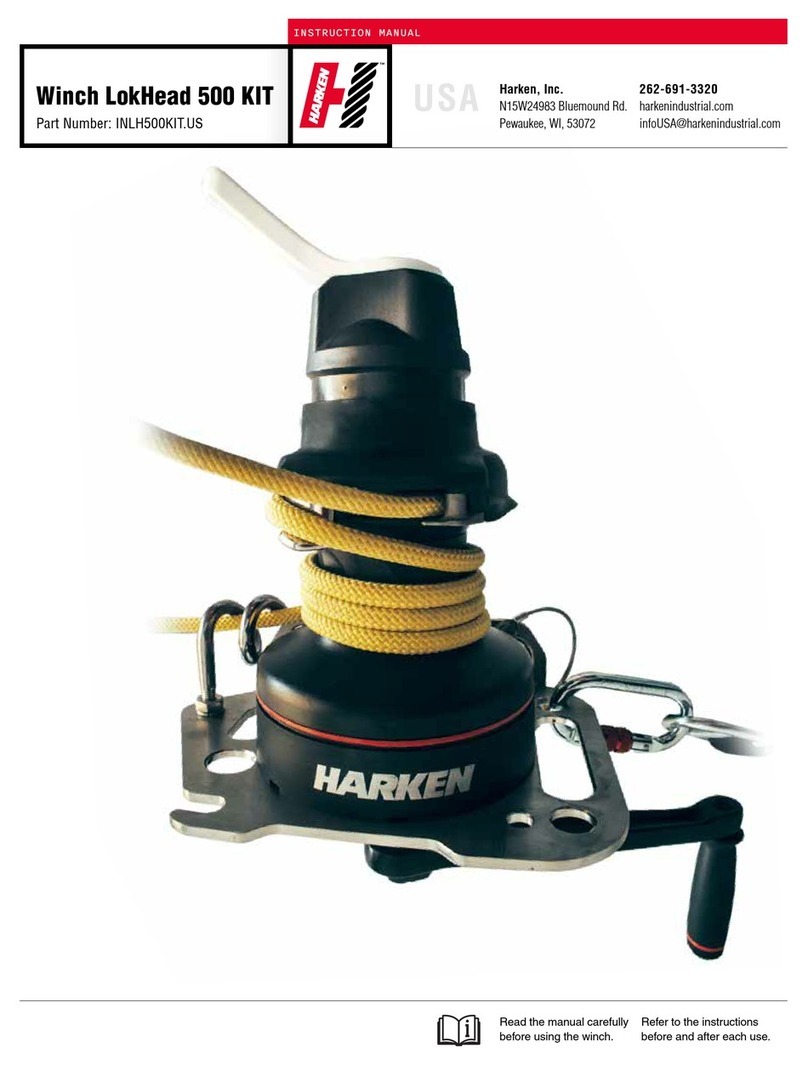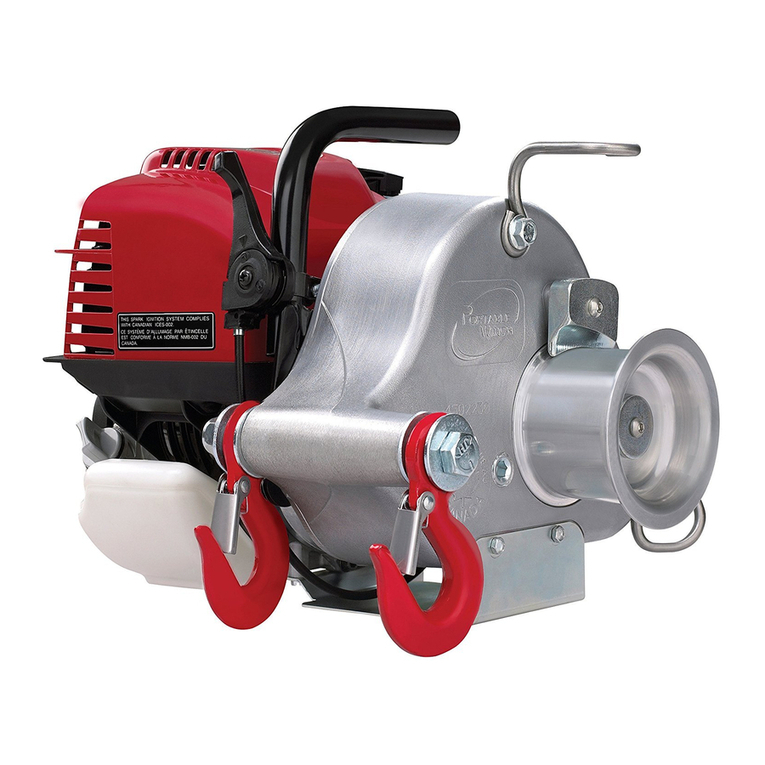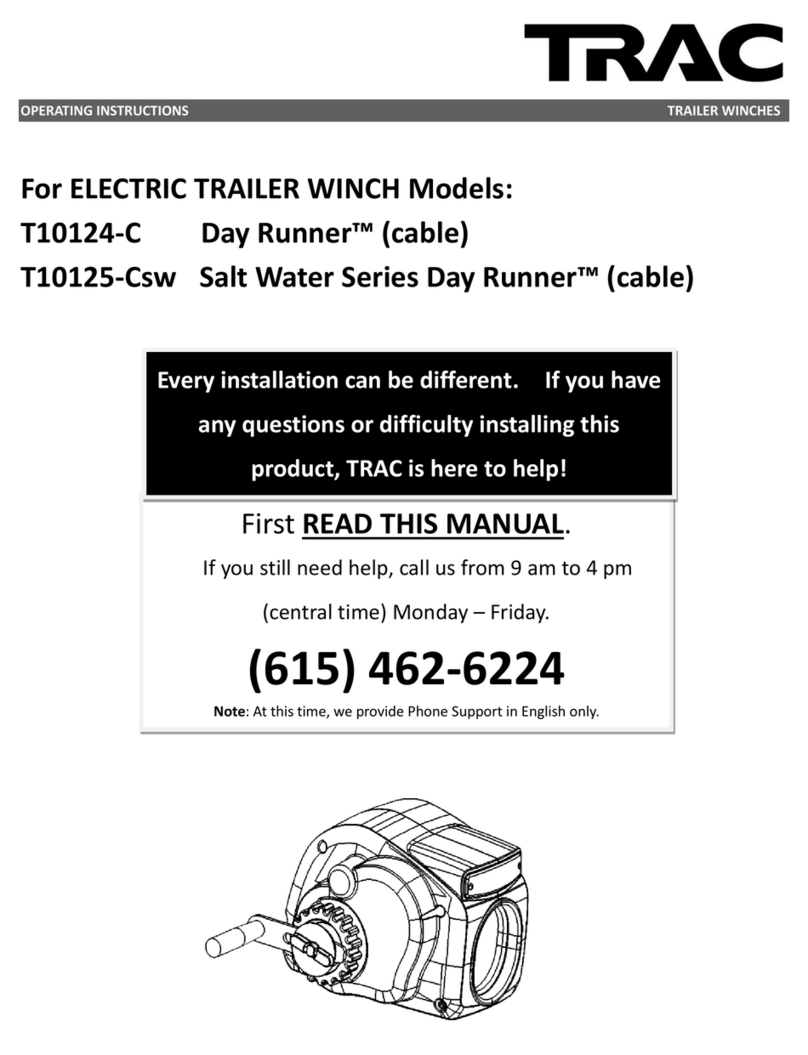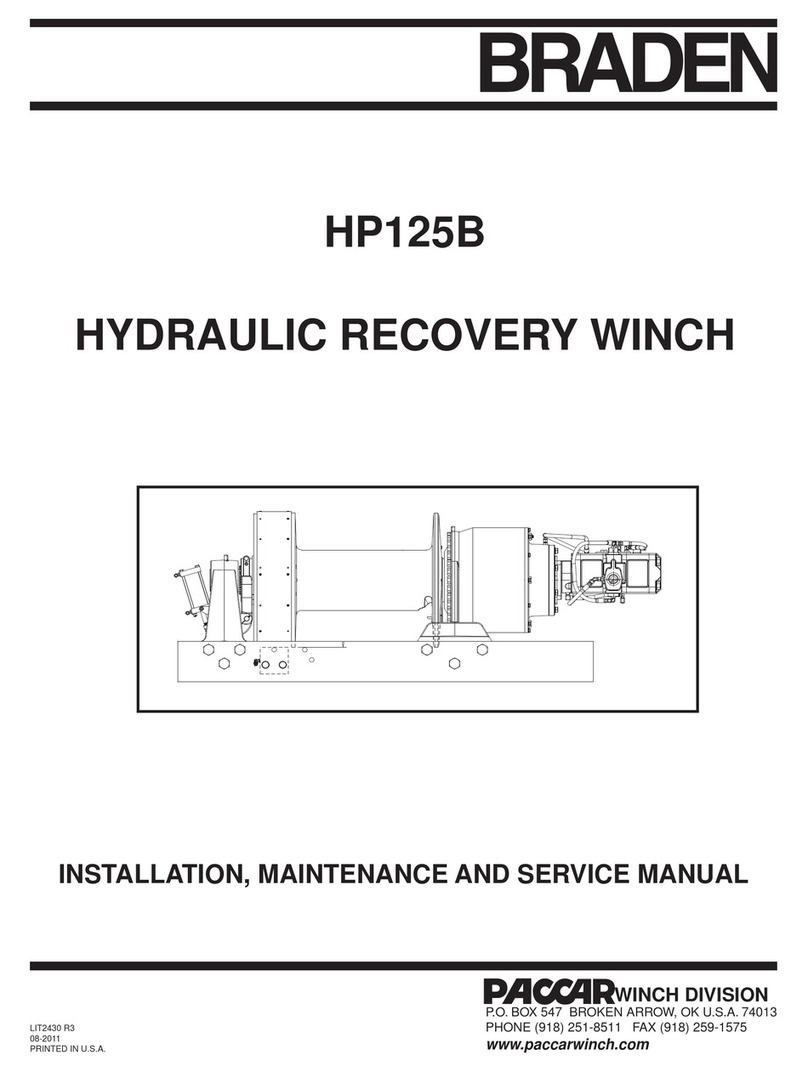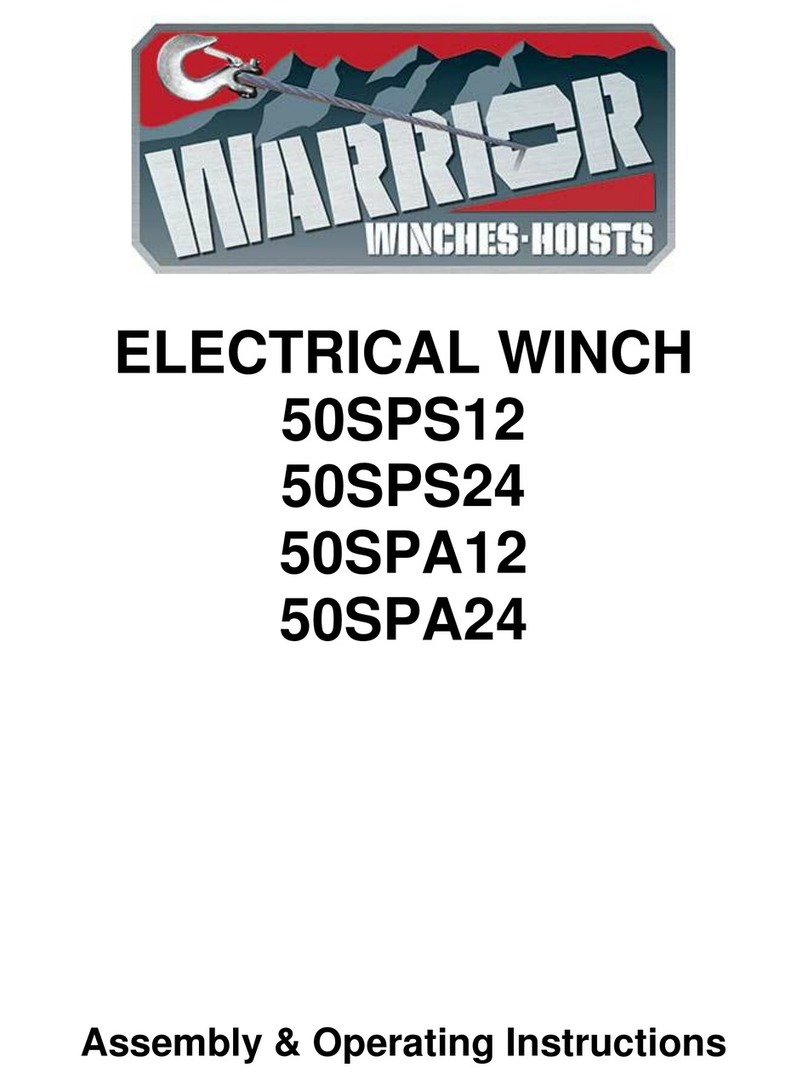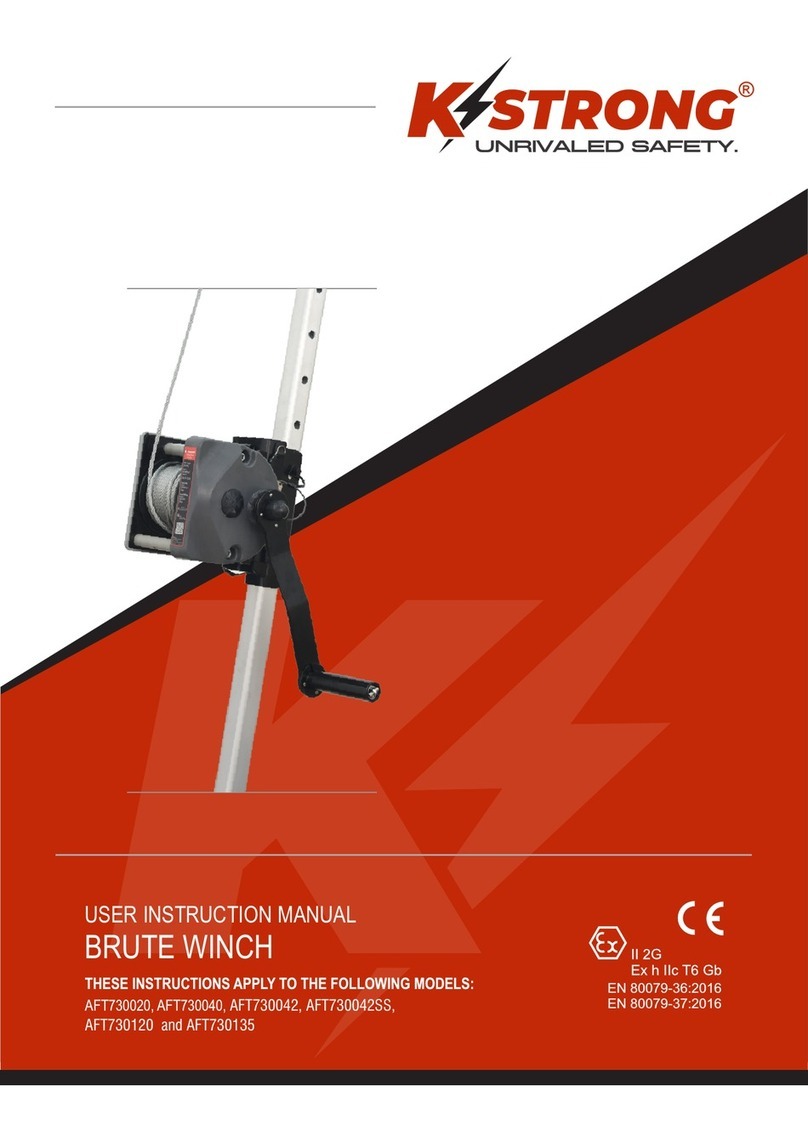Globestock G.Winch Operator's manual

Issue 004
G.Winch
ENGINEERING PROTECTION SINCE 1982
User
Instruction
Manual
(Original Instructions)
Issue 004.
December 2019.
Manually Operated Winch
for the Lifting of
Personnel.
Suitable for Frequent
Raising/Lowering of
Personnel
Directive 2006/42/EC
: +44 (0) 1691 654 966
: +44 (0) 1691 661 726
:
:
www.globestock.co.uk
t: @globestock_ltd
Globestock Limited, Mile Oak Industrial Estate, Maesbury Road, Oswestry,
Shropshire, SY10 8GA UK
0890


Issue 004
USE INSTRUCTIONS
Contents
1Important Notice............................................................................................ 1
2G.Winch for Lifting Personnel........................................................................ 2
2.1 Anchorage Requirements ...................................................................... 2
3Inspection Before Use .................................................................................... 3
4Considerations for Use................................................................................... 3
5Setup For Use ................................................................................................. 4
5.1 Attaching to the G.Tripod ...................................................................... 5
6Inspection And Maintenance......................................................................... 7
6.1 Periodic Examination ............................................................................. 7
6.2 Service and Re-certification................................................................... 7
6.3 Cleaning, Storage And Transportation .................................................. 7
Examination Record Card ...................................................................................... 8

1
Issue 004
1Important Notice
READ EQUIPMENT LABELS AND ‘USER INSTRUCTIONS’ BEFORE USING THIS PRODUCT.
BEFORE USING THIS EQUIPMENT IT IS ESSENTIAL THAT USERS ARE FULLY AWARE OF
HOW THE EQUIPMENT OPERATES, WHERE IT SHOULD BE USED, WITH A
PREDETERMINED ACTION PLAN FOR BOTH THE USE AND RECOVERY SHOULD AN
EMERGENCY ARISE.
This product has been developed to enable the safe entry of personnel into a restricted
access or confined space. Recommended use is in conjunction with a G.Saver II fall
arrest and retrieval device, to protect against potential falls occurring during use. The
G.Saver II also provides a backup retrieval system for use in an emergency or an
unforeseen occurrence.
This equipment is for use where other means of access are not practical.
When in use please observe the Maximum Working Load of both the G.Winch model and
the anchorage device or structure. The person raised or lowered should never be left to
work alone. There must always be another person present to supervise and operate the
G.Winch.
Both the person being raised/lowered and the equipment operator should be adequately
trained.
PRIOR TO USE:
A formal ‘Risk Assessment’ should be carried out, considering use and the
emergency rescue procedure.
Users should be fully conversant with the operation of the equipment.
The ‘Before Use Checks’ should be performed (see section 3 – Inspection Before
Use).
Verify that the maximum weight to be lifted is within the maximum working
load of all equipment to be used.

2
Issue 004
2G.Winch for Lifting Personnel
The G.Winch is a personnel winch fitted with a maximum of 50 metres of wire rope. For
confined space use and for the routine raising & lowering of personnel. For Example:
lifting personnel through areas of restricted access. It can be attached to the G.Tripod or
similar EN795 anchorage device. It can be used where regular lifting is required.
The G.Winch is recommended for use in conjunction with a Fall Arrest and Retrieval
device such as the G.Saver II. This system
then incorporates EN360 fall protection,
with an additional safety line to rescue
the user in the event of an unforeseen
occurrence.
Use in this manner provides the maximum
level of safety possible.
The winch handle has two possible
positions. When fitting the handle, ensure
that the wing screw is securely located
into one of the two locating depressions.
The G.Winch has an anti-run brake to
prevent the person supported or load
from falling to the ground should the
winch operator release the winding arm.
The mechanism provides an easy winding
action making personnel lifting easy. The
G.Winch is tough and durable, with a long
working life.
2.1 Anchorage Requirements
Use of an EN795 anchor device, such as the G.Tripod is recommended. Suitable brackets
are available. In any case the structure must be of adequate strength or rating to
accommodate the weight lifted. Beware of anchorages designed for materials handling,
they generally have lower strength requirements than should be used for lifting people.
Custom brackets used to adapt the G.Winch to fit an anchorage structure must be of
adequate strength. If in any doubt contact your supplier or the manufacturer for advice.

3
Issue 004
3Inspection Before Use
Before using the G.Winch inspect as follows.
Inspection
1. With the G.Winch mounted on an EN795 anchorage device such as the
G.Tripod. Inspect the mounting brackets.
2. With the winding arm removed from the winch, lift and hold up the pawl so
as to disengage the anti-run brake. Pull wire rope off the drum, releasing
the pawl. The Anti-Run brake should engage and lock firmly preventing
further rope from being pulled off the drum.
3. Attach the winch arm. Check that it is firmly held in place by the locking
screw. Rotate the winch arm to spool rope onto the drum. An audible
clicking should be made by the pawl to confirm the correct functioning of
the anti-run brake.
4. Inspect the entire system for any signs of damage, wear or malfunction.
5. Inspect the wire rope. No kinks, broken strands or excessive wear should be
observed.
6. Ensure the rope’s safety hook is free of damage and functions correctly, the
gate locks positively.
Before operating and During Use of the G.Winch visually check the equipment and the
path of the wire rope to ensure no fouling. The person raised / lowered and the winch
operator both need to be vigilant before and during use. It is then safe to rotate the
winding arm.
4Considerations for Use
•Do not Exceed the Maximum working load of the G.Winch model.
•Should any doubt arise about the safe condition of this device DO NOT USE. Return
to Globestock or a Globestock authorised servicing agency for assessment, service
and re-certification, before further use
•The G.Winch weighs approximately 21kg. Manual handling and attaching to the
G.Tripod should be performed by 2 people.
•This equipment must be used by at least two people, one to operate the winch as
the other is lowered / raised.
•The G.Winch operator should maintain communication at all times with the person
being lowered / raised.
•The G.Winch may only be used by trained or otherwise competent persons.
•Personnel Protective Equipment should be worn when using this equipment. For
Example: Gloves, Safety Glasses, safety shoes, etc.
•Wear gloves to protect your hands when inspecting or handling the wire rope.

4
Issue 004
•During a lifting operation keep hands clear of the rope drum, as the winch line pulled
onto the drum can trap and cause injury to fingers.
•The G.Winch should only be used within the temperature range of -15˚ to 60˚
centigrade. If the intended use is outside of this range then consult supplier or
manufacturer for guidance.
•The G.Winch is recommended for use in conjunction with a Fall Arrest and Retrieval
device such as the G.Saver II. This provides a secondary safety line, with fall
protection and emergency retrieval, ensuring maximum safety of the person being
raised or lowered
•Ensure the path of travel of the person to be raised or lowered, is free of
obstructions.
•Attach the rope’s safety hook directly to the person’s body harness attachment
point or the connection point on the carrier.
•The last meter of rope is coloured red to indicate the rope is near it’s end, this
section is not to be used and is addition to the stated length of rope.
•Do not allow slack cable during use. This cable may tangle or foul, hindering the safe
retrieval of the user and it may make it possible for the user to fall, causing fatal
injury.
•Do not allow the rope safety line to pass over sharp edges, electrical items/cables.
•Do not allow the rope safety line to become frayed or to kink as this weakens the
rope.
•A clearly understood, predetermined action plan should be in place and
implemented in the event of an emergency.
•Do not disengage the Anti-Run Brake while the G.Winch is under load.
5Setup For Use
If in any doubt please contact either a specialist or Globestock for advice.
Connect the G.Winch to a suitable anchorage such as an EN795 device. The G.Tripod is
the ideal anchorage device. The additional use of a G.Saver II provides an additional
safety line, giving the maximum level of safety.
The equipment should be inspected and setup in a safe area. All pre-use checks must be
completed before the assembly can then be moved into place by two or more people, so
that it is ready for use. Perform a final visual inspection, and the equipment is ready to
use.
Before operating the G.Winch visually check the path of the wire rope and the
equipment to ensure no fouling. Check with the user to ensure he/she is ready. It is
then safe to rotate the winding arm.

5
Issue 004
5.1 Attaching to the G.Tripod
See Figure 2, Page 6
1. The G.Tripod should be opened up and set down on it’s feet at the lowest
setting.
2. Lay the G.Winch next to one of the side legs of the G.Tripod and lay the
G.Saver II next to the fixed leg.
3. Pull back the G.Winch’s pawl and hold, so the anti-run brake is temporarily
disconnected. Pull 3 metres of rope off the drum.
4. Fit the rope through the pulley assembly, then attach the pulley assembly to
the Anchorage point underneath the Tripod head. Ensure the screw gate of
the karabiner is securely locked.
5. Fit the rope of the G.Saver II, over the pulley on top of head of the G.Tripod,
and secure.
6. Raise the G.Tripod to the required height. Take the first leg and extend it to
the first intermediate setting. Then take the second leg, extend it to the
desired height and repeat with the third leg. Finally adjust the first leg so all
legs are at the same height.
7. Attach the G.Saver II to the upper fixed leg of the G.Tripod, as shown in the
picture, figure 2.
8. With the G.Winch on the ground, unscrew the mounting bracket lever arms,
so that the winch is ready to fit to the G.Tripod.
9. Attaching the G.Winch to the G.Tripod is best performed by two people. Lift
together, the G.Winch onto the top of the tripod leg.
10. One person holds the winch in place, with the weight of the winch supported
by the tripod leg. The other person fastens the brackets to hold the winch
onto the leg.
11. With the brackets loose, the winch is rotated around the leg so that it is on
the underside, in line with the path of the rope and the pulley. Both brackets
are then securely tightened.
12. Both the ropes hanging at the centre of the tripod can be attached back to
their respective devices, taking up slack wire rope.
13. The Access System can then be visually inspected before moving into place
over the access hole.

6
Issue 004
Figure 2 – Attaching to the G.Tripod
G.Tripod
Pulley
Assembly
G.Winch
G.Saver II

7
Issue 004
6Inspection And Maintenance
Like all safety critical complex mechanical devices, the G.Winch requires regular
inspection and maintenance to ensure that the unit functions safely and correctly.
Repairs or servicing should never be carried out on site or in the field. Do not tamper
with or modify the unit.
6.1 Periodic Examination
The G.Winch should be periodically inspected by a competent person at least once in
every 6 months dependant upon the frequency of use and the operating environment.
The ‘Inspection Record’ found on the page opposite in this booklet, outlines the main
examination criteria. On passing this detailed inspection the record opposite can be
completed, signed off and the unit returned for use. Any observed faults must be
rectified. If necessary or in any doubt, return the G.Winch for service, test and re-
certification.
6.2 Service and Re-certification
The G.Winch must be returned for servicing annually or if any doubt should arise
concerning the units condition. Globestock or a Globestock approved servicing agency
can be used for this. On completion of a service and retest, a new Test Certificate will be
issued which validates the unit for a further year of use.
6.3 Cleaning, Storage And Transportation
The G.Winch’s exterior may be cleaned using warm water with a mild detergent. It
should then be allowed to dry.
In order to maintain the wire rope safety line, remove any soiling. Apply a little light oil
to a cloth. Hold the cloth around the rope, allowing the rope to pass through the cloth.
This will leave the rope lightly oiled.
The unit should be stored in a clean, dry, chemical free environment.
When transporting the G.Winch, it should be boxed or retained to prevent damage or
deterioration.

G-WINCH
Manufacture Date:
Serial No:
Case /
Housing
Function
Cable
Karabiner
Anti-Run
Brake
Clicking sound as handle is turned
Pawl moves freely / is unobstructed
Pawl is free from damage
Mechanism locks when cable pulled
out (10kg force )
Free of severe corrosion
Thimble present
Anchor plate secure
Gate functions freely
Swivel action operates
Free of damage & corrosion
Fasteners present & secure
S.W.L present
Serial Number present & legible
Smooth action as handle turned
Rope Drum rotates freely
No broken stands or kinks
cation.
DATE
General Condition
Free of excessive corrosion
Free of warp/damage & cracks
INSPECTION RECORD CARD
SIGN
Record of
Service
& Recertifi-

9
Issue 004
Other manuals for G.Winch
1
Table of contents
Other Globestock Winch manuals
Popular Winch manuals by other brands
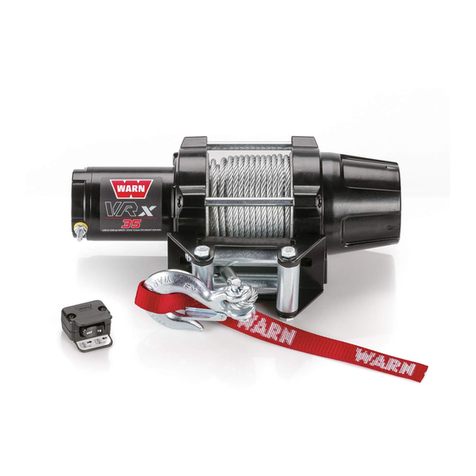
Warn
Warn VRX 25 Operator's manual
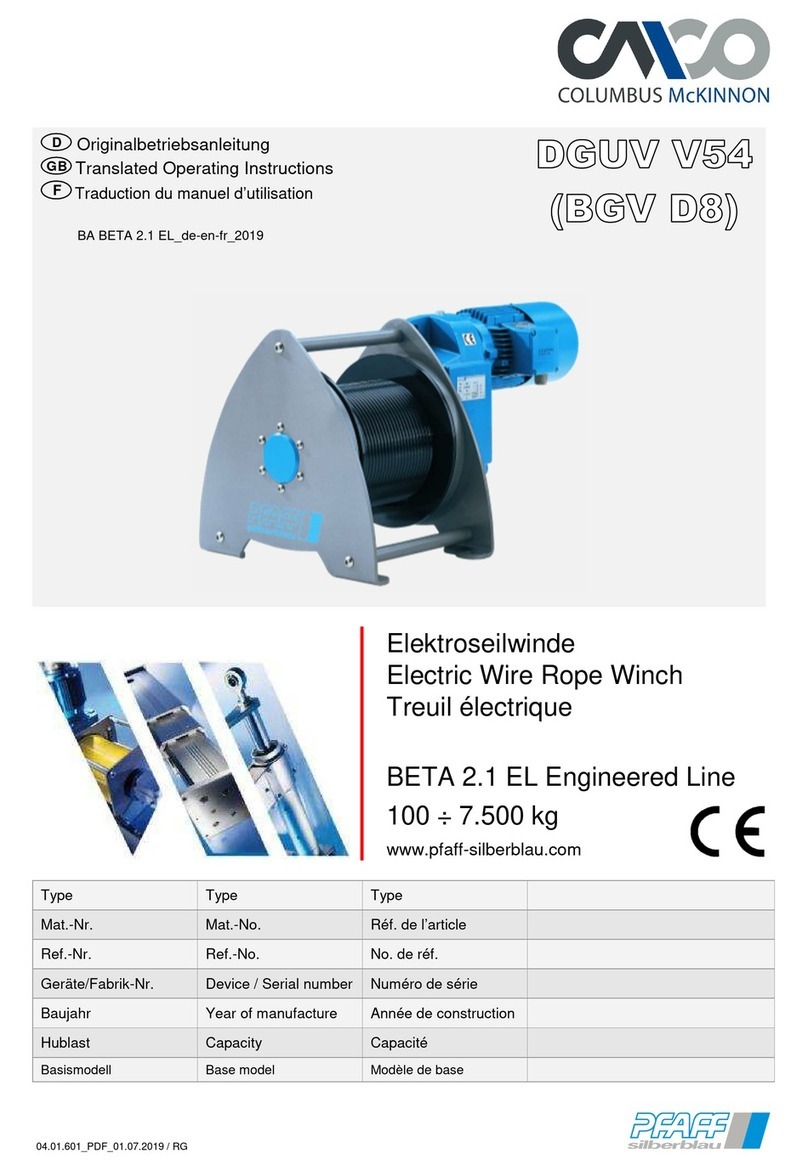
PFAFF silberblau
PFAFF silberblau DGUV V54 Translated Operating Instructions

Harken
Harken 46.2 PTBBB Installation and maintenance manual
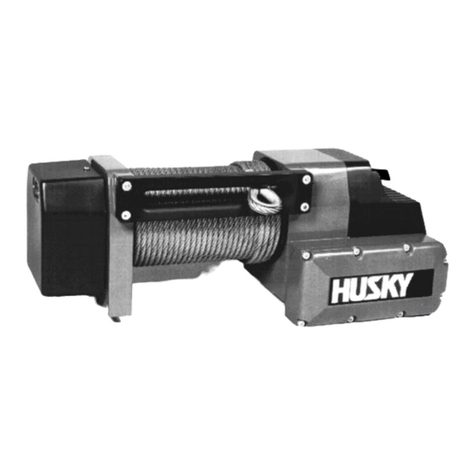
Superwinch
Superwinch Husky series Owner Manual and Fitting Instructions
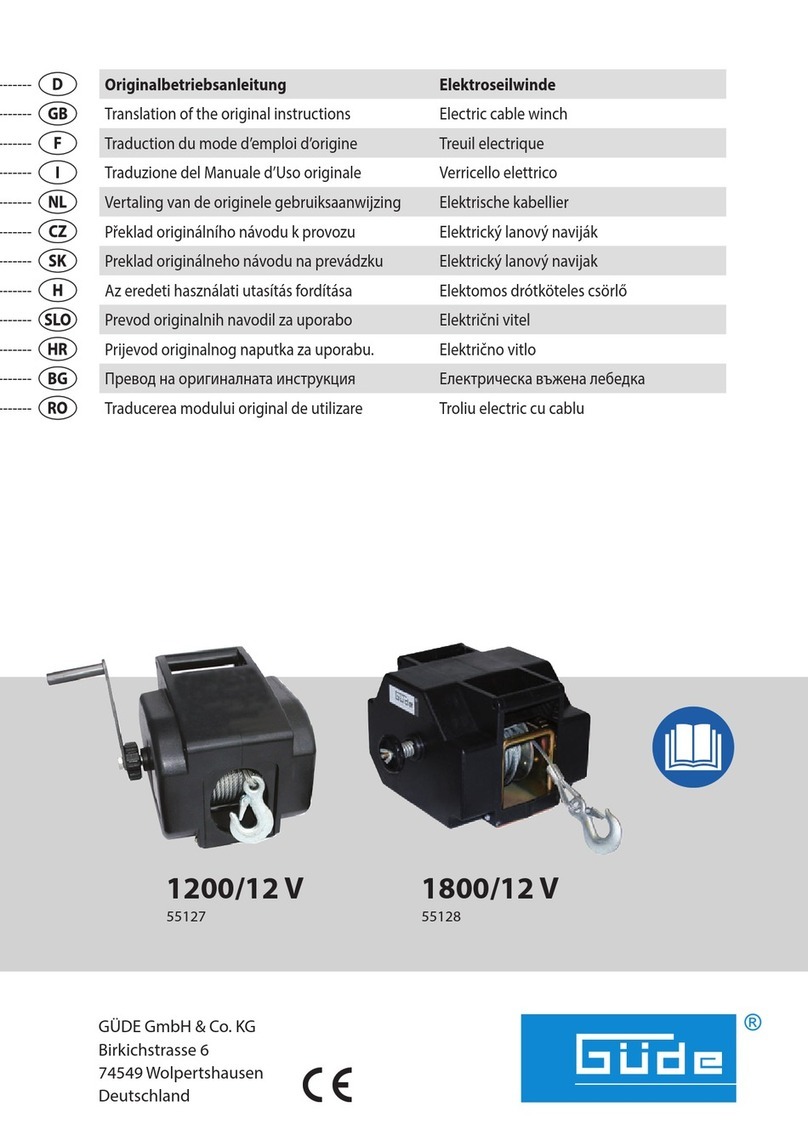
Gude
Gude 1200/12 V Translation of the original instructions
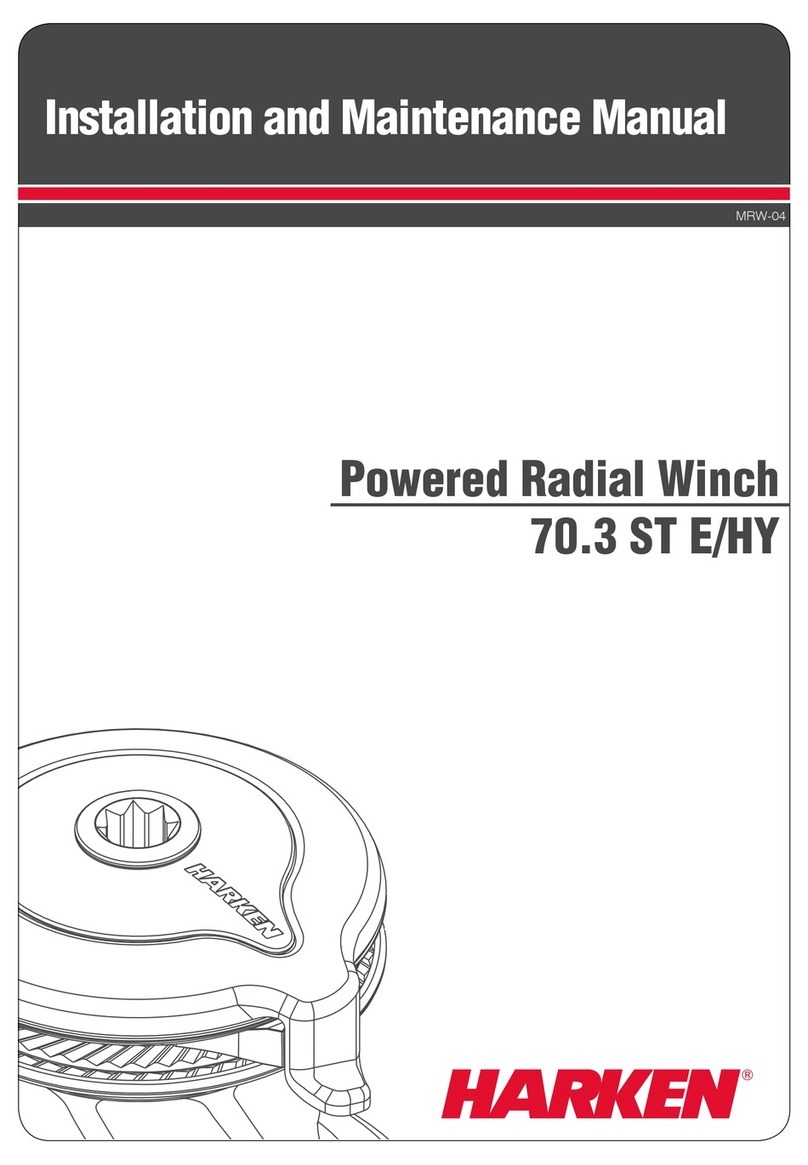
Harken
Harken 70.3 ST E Installation and maintenance manual
